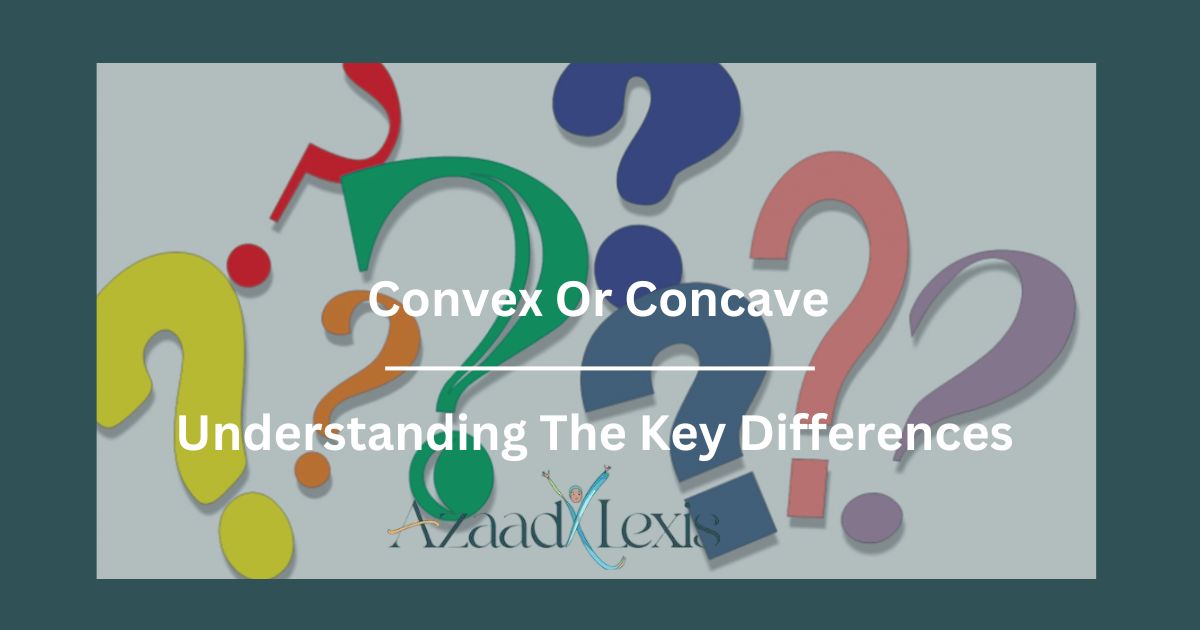When you hear the terms convex and concave, you might think of shapes, but these terms are used in many fields like optics, geometry, and everyday life. It’s important to understand the key differences because they help us understand how light behaves, how we use mirrors, and even how we see things clearly through lenses.
The differences between convex and concave surfaces affect how objects are reflected, magnified, or focused.
What is a Convex Surface?
A convex surface is a surface that curves outward. Think about the shape of a basketball or the back of a spoon. This outward curve reflects light rays, making the reflected image smaller. In optics, convex lenses are used to focus light, such as in magnifying glasses or telescopes. They bring light rays together, creating a focused image.
Everyday examples of convex surfaces include the lens of eyeglasses for farsightedness, the mirrors in a rearview mirror, and the lenses in a telescope. In all these cases, convex surfaces are used to either magnify or make objects clearer from a distance. Convex mirrors are especially helpful because they offer a wider field of view, making them useful in parking lots and on the roads.
What is a Concave Surface?
A concave surface is the opposite. It curves inward, like the inside of a spoon or a bowl. When light rays hit a concave surface, they are focused inward. This can make objects appear larger, and the reflection is more magnified. Concave mirrors are used for a variety of purposes, from dental mirrors to telescopes used for stargazing.
Everyday examples of concave surfaces include bathroom mirrors, satellite dishes, and dental mirrors used by dentists. In optics, concave lenses are used to correct short-sightedness or myopia by spreading light rays apart. This is how glasses for people with nearsightedness work.
Read this Blog: 25 Ways to Say “Sincerely” Professionally
Quick Comparison: Concave vs Convex
Here’s a quick comparison between concave and convex surfaces:
| Feature | Convex | Concave |
| Shape | Outward curve | Inward curve |
| Light Rays | Diverge (spread out) | Converge (focus together) |
| Images | Smaller, upright | Larger, inverted or magnified |
| Common Uses | Security mirrors, telescopes, farsightedness | Magnifying glasses, dental mirrors, short-sightedness |
Key Differences Between Convex and Concave
The main geometrical difference between convex and concave is the direction in which they curve. A convex surface curves outward, while a concave surface curves inward. These shapes affect how light interacts with them. On a concave mirror, light rays converge or come together. On a convex mirror, they diverge or spread out.
Another difference is how the two surfaces impact how we see things. Convex mirrors create smaller, upright reflections that give a broader field of view. On the other hand, concave mirrors can create enlarged or inverted images, depending on the distance from the mirror. In lenses, a concave lens helps people with short-sightedness see distant objects clearly, while a convex lens helps people with farsightedness see nearby objects clearly.
Convex vs Concave: Real-World Applications
Concave mirrors are widely used in everyday life. For example, you can find them in dental mirrors, which help dentists get a clear view of your teeth. They are also used in flashlights and telescope mirrors to focus light rays on a single point. In astronomy, concave mirrors are found in observatories to gather more light from distant stars in the night sky.
Convex mirrors are used for completely different reasons. Security mirrors, like those used in parking lots, are usually convex because they provide a wide field of view. They are also used in rearview mirrors to show a broader image of what’s behind the vehicle. Convex lenses are crucial for farsightedness, and they are used in magnifying glasses and optical instruments like telescopes and microscopes.
When to Use Convex and When to Use Concave
Knowing when to use a convex or concave surface is important for making the right choice for different needs. Convex mirrors are ideal when you need a wide view, like in security or parking. On the other hand, concave mirrors are perfect for focusing or magnifying images, like when you need a magnifying glass or a dental mirror.
When it comes to lenses, you’ll want to choose concave lenses for correcting short-sightedness and convex lenses for correcting farsightedness. These lenses focus light rays in different ways to help us see clearly.
Tips to Remember the Difference Between Concave and Convex
It can be tricky to remember the difference between concave and convex, but there are some simple tricks. One helpful tip is to remember the word cave in concave. Just like a cave goes inward, concave surfaces curve inward too. Convex surfaces, on the other hand, curve outward, like the outside of a basketball.
Visual aids can also help. Think about the spoon you use to eat soup. If the inside of the spoon is facing you, it’s a concave surface. If the outside of the spoon is facing you, it’s convex.
Final Words
In conclusion, convex and concave surfaces are crucial to our understanding of how light behaves, whether in mirrors, lenses, or even in the natural world. These surfaces are used in everyday tools like magnifying glasses, telescopes, and even satellite dishes. By understanding the differences between concave and convex, you can choose the right tools for various purposes, from focusing light to creating wide field of view for security.
Remembering the difference is simple when you think of concave as curving inward like a cave and convex as curving outward like a basketball. These two shapes are not just useful in optics but also in everyday life, from dentists’ mirrors to the lenses in sunglasses that protect against glare. Understanding how light rays behave on these surfaces will always give you a clearer picture of the world around you.

